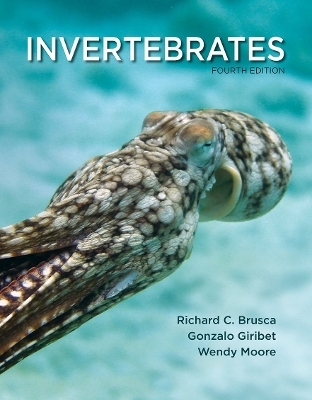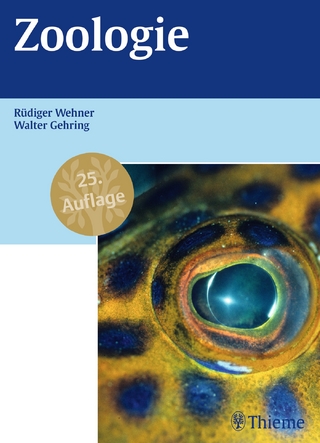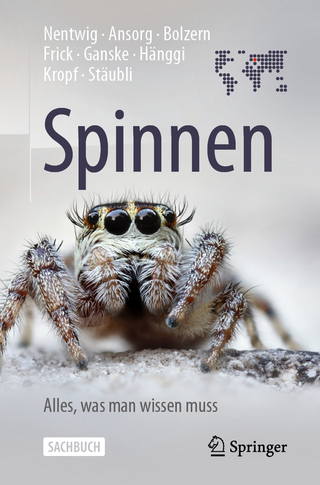
Invertebrates
Oxford University Press Inc (Verlag)
978-0-19-755441-8 (ISBN)
Invertebrates is a complete, trusted, and engaging textbook whose comprehensive coverage makes it an invaluable resource for both undergraduate and graduate courses and professional researchers. The 3rd edition has been widely praised for its detailed classifications, high-quality illustrations, and coverage of contemporary debates in the field. The 4th edition will continue to feature recent scholarship and current perspectives, while streamlining the text to improve accessibility for intro-level students. Gonzalo Giribet joins as coauthor, contributing his phylogenomic expertise as an Evolutionary Biologist and Phylogeneticist, and Director of Harvard's Museum of Comparative Zoology.
Richard C. Brusca, Ph.D., University of Arizona, is Executive Director Emeritus of the Arizona-Sonora Desert Museum and a Research Scientist in the Department of Ecology and Evolutionary Biology at the University of Arizona. Dr. Brusca is the author of over 200 research publications and 15 books, and the recipient of more than 100 research grants from the National Science Foundation, NOAA, and the National Geographic Society, and many others. He is a Fellow of the American Association for the Advancement of Science, the Linnean Society of London, and the California Academy of Sciences. His research interests include invertebrate zoology, the natural history of the Sonoran Desert and Gulf of California, and ecology of Arizona's Madrean Sky Islands. Gonzalo Giribet, Ph.D., University of Barcelona, is Alexander Agassiz Professor of Zoology, Curator of Invertebrates and Director of the Museum of Comparative Zoology, Harvard, and a Professor in the Department of Organismic and Evolutionary Biology. In addition, he holds an Doctor Honoris Causa from the University of Copenhagen, and he an Honorary Research Fellow at The Natural History Museum, London, a Fellow of the California Academy of Sciences, and a 2016 Fellow of the John Simon Guggenheim Memorial Foundation. He has published more than 400 scientific articles and book chapters, and has named more than 100 new species, genera, and families of invertebrates. His research is broadly interested in the origins and maintenance of animal diversity, which he explores through studying the evolution, systematics, and biogeography of invertebrate animals. Wendy Moore, Ph.D., University of Arizona, is Associate Professor in the Department of Entomology at the University of Arizona and Curator of the University of Arizona Insect Collection. Her long-term research interest is the evolution of diversity, particularly of invertebrates and especially of insects. She is a systematist who uses molecular-based phylogenetics to understand the evolution of morphology and how biotic, climatic, and tectonic events may have influenced the timing and patterns of diversification. She is also committed to natural history collections care and enhancement, and the use of bioinformatics to make collections-based data widely available to diverse user communities.
Chapter 1: IntroductionKeeping Track of LifeProkaryotes and EukaryotesWhere Did Invertebrates Come From?Where Do Invertebrates Live?Changing Views of Invertebrate PhylogenyA Final Introductory Message to the ReaderChapter 2: Systematics, Phylogeny, and ClassificationPhylogeny, Monophyly, Paraphyly, and PolyphylyHomologyApomorphy and PlesiomorphyChallenges of Phylogenetic InferenceConstructing PhylogeniesBiological ClassificationNomenclatureChapter 3: Introduction to the Animal Kingdom: Animal Architecture and Body PlansBody SymmetryCellularity, Body Size, Germ Layers, and Body CavitiesLocomotion and SupportCilia and FlagellaFeeding and DigestionExcretion and OsmoregulationCirculation and Gas ExchangeNervous Systems and Sense OrgansBioluminescenceNervous Systems and Body PlansHormones and PheromonesReproductionChapter 4: Introduction to the Animal Kingdom: Development, Life Histories, and OriginEvolutionary Developmental Biology: Evo-DevoEggs and EmbryosLife Cycles: Sequences and StrategiesThe Relationships Between Ontogeny and PhylogenyThe Origin of the MetazoaChapter 5: Phylum Porifera: The SpongesTaxonomic History and ClassificationThe Poriferan Body PlanSome Additional Aspects of Sponge BiologyPoriferan PhylogenyChapter 6: Two Enigmatic Phyla: Placozoa and Ctenophora (The Comb Jellies)Phylum CtenophoraTaxonomic History and ClassificationThe Ctenophoran Body PlanCtenophoran PhylogenyChapter 7: Phylum Cnidaria: Anemones, Corals, Jellyfish, and Their KinTaxonomic History and ClassificationThe Cnidarian Body PlanCnidarian Evolutionary HistoryChapter 8: A Brief introduction to the Bilateria and Its Major CladesDeuterostomes and ProtostomesChapter 9: Phylum Xenacoelomorpha. Basal BilateriansThe Basal BilaterianPhylum XenacoelomorphaSubphylum AcoelomorphaClass AcoelaThe Acoel Body PlanClass NemertodermatidaThe Nemertodermatid Body PlanSubphylum XenoturbellidaThe Xenoturbellid Body PlanChapter 10: Protostomia, Spiralia, and the Phylum Dicyemida + Spiralia and EcdysozoaThe Phylum Dicyemida (= Rhombozoa)Anatomy and Biology of DicyemidansLife CyclesChapter 11: Gnathifera. The Phyla Gnathostomulida, Rotifera (including Acanthocephala), Micrognathozoa, and Chaetognatha + Phylum Gnathostomulida: The GnathostomulidsThe Gnathostomulid Body PlanPhylum Rotifera: The Free-Living RotifersThe Rotifer Body PlanBody Cavity, Support, and LocomotionNervous System and Sense OrgansReproduction and DevelopmentPhylum Rotifera, Subclass Acanthocephala: The AcanthocephalansThe Acanthocephalan Body PlanPhylum Micrognathozoa: The MicrognathozoansThe Micrognathozoan Body PlanPhylum ChaetognathaChaetognath ClassificationThe Chaetognath Body PlanReproduction and DevelopmentChapter 12: Platytrochozoa and Two Enigmatic Phyla: Entoprocta and Cycliophora + Phylum Entoprocta: The EntoproctsThe Entoproct Body PlanPhylum Cycliophora: The CycliophoransChapter 13: Introduction to the Lophotrochozoa, and the Phylum Mollusca + The LophotrochozaPhylum MolluscaTaxonomic History and ClassificationThe Molluscan Body PlanMolluscan Evolution and PhylogenyChapter 14: Phylum Nemertea: The Ribbon Worms + Taxonomic History and ClassificationThe Nemertean Body PlanNemertean PhylogenyChapter 15: Phylum Annelida. The Segmented (and Some Unsegmented) Worms + Taxonomic History and ClassificationThe Annelid Body PlanSipuncula: The Peanut WormsSipunculan ClassificationThe Sipunculan Body PlanThalassematidae: The Spoon WormsSiboglinidae: Vent Worms and Their KinSiboglinid Taxonomic HistoryThe Siboglinid Body PlanHirudinea: Leeches and Their RelativesThe Hirudinean Body PlanOrthonectida: Extremely Simplified AnnelidsAnnelid PhylogenyChapter 16: The Lophophorata: Phyla Phoronida, Bryozoa, and Brachiopoda + Taxonomic History of the LophophoratesThe Lophophorate Body PlanPhylum Phoronida: The PhoronidsThe Phoronid Body PlanPhylum Bryozoa: The Moss AnimalsThe Bryozoan Body PlanPhylum Brachiopoda: The Lamp ShellsThe Brachiopod Body PlanChapter 17: Rouphozoa: The Phyla Platyhelminthes (Flatworms) and Gastrotricha (Hairy-Bellied Worms) + Introduction to RouphozoaThe Phylum Platyhelminthes (Flatworms)Taxonomic History and ClassificationThe Platyhelminth Body PlanPlatyhelminth PhylogenyPhylum Gastrotricha: The Gastrotrichs, or Hairy-Bellied WormsThe Gastrotrich Body PlanReproduction and DevelopmentChapter 18: Introduction to Ecdysozoa: Scalidophora (Phyla Kinorhyncha, Priapula, Loricifera) + Introduction to EcdysozoaThe ScalidophoraPhylum Kinorhyncha: The Kinorhynchs, or Mud DragonsThe Kinorhynch Body PlanPhylum Priapula: The Priapulans, or Penis WormsPriapulan Body PlanNervous System and Sense OrgansPhylum Loricifera: The LoriciferansChapter 19: Nematoida: Phyla Nematoda and Nematomorpha + Phylum Nematoda: RoundwormsNematode ClassificationThe Nematode Body PlanLife Cycles of Some Parasitic NematodesPhylum Nematomorpha: Horsehair Worms and Their KinThe Nematomorph Body PlanChapter 20: Panarthropoda and the Emergence of the Arthropods. Tardigrades, Onychophorans, and the Arthropod Body Plan + Phylum TardigradaThe Tardigrade Body PlanPhylum OnychophoraThe Onychophoran Body PlanAn Introduction to the Phylum ArthropodaThe Arthropod Body Plan and ArthropodizationThe Evolution of ArthropodsChapter 21: Phylum Arthropoda. Subphylum Crustacea: Crabs, Shrimps, and Their Kin + Classification of the CrustaceaSynopses of Crustacean TaxaThe Crustacean Body PlanCrustacean PhylogenyChapter 22: Phylum Arthropoda. Hexapoda: Insects and Their Kin + The Hexapod Body PlanHexapod EvolutionChapter 23: Phylum Arthropoda. Subphylum Myriapoda: Centipedes, Millipedes, and Their Kin + Myriapod ClassificationThe Myriapod Body PlanMyriapod PhylogenyChapter 24: Phylum Arthropoda. The Chelicerata + Synopses of Living Chelicerate Groups*The Euchelicerate Body PlanThe Class PycnogonidaThe Pycnogonid Body PlanChelicerate PhylogenyChapter 25: Introduction to Deuterostomia, and the Phylum Hemichordata + Introduction to the DeuterostomiaPhylum Hemichordata: Acorn Worms and PterobranchsThe Hemichordate Body PlanClass Enteropneusta (Acorn Worms)Class Pterobranchia (Pterobranchs)Hemichordate Fossil Record and PhylogenyChapter 26: The Phylum Echinodermata + The Phylum EchinodermataTaxonomic History and ClassificationThe Echinoderm Body PlanEchinoderm PhylogenyChapter 27: Phylum Chordata: Cephalochordata and Urochordata + Phylum Chordata, Subphylum Cephalochordata: The LanceletsThe Cephalochordate Body PlanPhylum Chordata, Subphylum Urochordata: The TunicatesThe Tunicate Body PlanChordate PhylogenyChapter 28: Perspectives on Invertebrate Phylogeny
| Erscheinungsdatum | 03.05.2022 |
|---|---|
| Verlagsort | New York |
| Sprache | englisch |
| Maße | 276 x 216 mm |
| Gewicht | 2948 g |
| Themenwelt | Naturwissenschaften ► Biologie ► Zoologie |
| ISBN-10 | 0-19-755441-5 / 0197554415 |
| ISBN-13 | 978-0-19-755441-8 / 9780197554418 |
| Zustand | Neuware |
| Haben Sie eine Frage zum Produkt? |
aus dem Bereich


